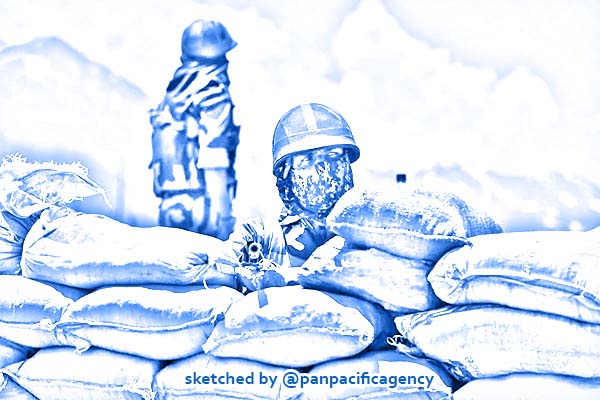India-China trade booms despite border woes

Indian soldiers guard a highway leading to the Ladakh region. Photo: DPA. Sketched by the Pan Pacific Agency.
NEW DELHI, Feb 25, 2022, ST. India may have banned a larger number of apps from China amid long-running border tensions but a trade deficit in favour of China is growing. The trade deficit with China has grown from US$56.8 billion (S$77 billion) in 2019 to US$69.4 billion in 2021, with two-way trade hitting a record US$125 billion in 2021, The Straits Times reported.
The two countries have had a fractious relationship following a border clash in 2020 in which soldiers from both sides lost their lives.
The incident inalienably altered the dynamics of the relationship, with New Delhi saying it cannot be business as usual. Last week, the Indian government banned 54 apps, taking the total Chinese apps banned to 321 over the last two years.
Both sides have only held border talks over the last two years amid the chill in ties.
“There has been disequilibrium in India-China trade throughout. Trade volume has become bigger and it has become a bigger problem especially when the relationship is not going in the right direction,” said Prof B.R. Deepak of Jawaharlal Nehru University.
Still, trade experts have found a silver lining in the import statistics, as imports from China went up to US$78.88 billion between January to November in 2021 as against US$52.16 billion for the same period in 2020.
An analysis of the top 100 trade items of more than US$100 million in value showed that only half were finished products, said Mr Santosh Pai, a corporate lawyer and honorary fellow at the Institute of Chinese Studies.
The other half were goods that went towards the manufacturing of a product like air conditioner parts, or active pharmaceutical ingredients such as penicillin.
Major imports were electrical products like unassembled solar cells and electric inverters, mechanical products like air compressors for air conditioners, and chemicals.
“There is good and bad in the statistics. Whatever we were importing in high quantities has increased further. The good thing is we are importing more intermediates. So we must be manufacturing something in India,” said Mr Pai.
“The question is how much of this is sustainable and whether this is Covid-19 disruption and pent-up demand. In the coming years, whatever we continue taking from China in higher quantities will give a clear indication of whether trade is going up among intermediates, which would mean manufacturing has picked up in a sustainable manner even after Covid-19.”
India has also been seeking to reduce its trade dependence on China because of the pandemic, which caused supply chain disruptions. The government has introduced schemes, including incentives, but pushing manufacturing is not expected to be easy or fast.
“These (trade) results imply that imports from China are complementing domestic production largely because of non-availability of critical inputs domestically. With the underdevelopment of critical industries like machine tools, steel, chemicals and electronic components, and with low operational efficiency, the requirement of domestic manufacturing is largely met through imports,” said Dr Sunitha Raju, a professor at the Indian Institute of Foreign Trade.
She also noted that the picture was not always clear sometimes, as it was difficult to differentiate between finished goods and parts, as India went from importing phones to parts for assembling following an increase in tariff imports and anti-dumping duty.
“These are not considered as final goods but components. But, in effect, they are final goods.”
Trade with China has stayed the course as it is dictated by market forces, unlike investment where India has restricted access for Chinese firms in areas like telecommunications.
But some see the trade relationship also altering, potentially permanently, due to the pandemic and the push for decoupling from China on the back of border troubles.
“Some of these figures tell you the changing profile of India’s import basket. It shows the story of rising manufacturing,” said Mr Sachin Chaturvedi, director-general at think-tank Research and Information System for Developing Countries.
“Local brands are coming up and local value chains are coming up and more and more products are being sourced from different countries.”